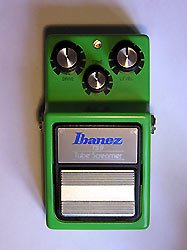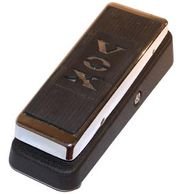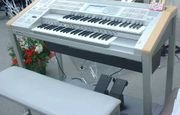
The TS9 Tubescreamer from, a popular pedal adding vacuum tube-like distortion (via transistors) to the output signal from electric instruments.
An effects pedal, or stomp box, is an effects unit housed in a small metal chassis, used by musicians, usually guitar players,
but sometimes players of other string instruments. These devices alter the sound quality or timbre of the input signal, adding effects such
as distortion, fuzz, overdrive, chorus, reverb, wah-wah, flanging, or phaser. They are called pedals or stomp boxes because they sit on the
floor and have large on/off switches on top that are activated by foot. Some, such as wah-wah or volume pedals, are also manipulated while in
operation by moving a large foot-activated potentiometer.
Usage
The pedal is connected to the signal chain utilizing two 1/4" jack plugs (or "phone plugs") (in/out). Some stomp boxes have stereo out via two
mono out signals, and a few have stereo jacks for both input and output (though this is quite uncommon). Several pedals can be linked together
in a chain. When a pedal is off or inactive, the signal coming in to the pedal is shunted onto a bypass, so that the "dry" or unaffected signal
can go on to other effects down the chain, and thus any combination of effects on a chain can be created without having to reconnect boxes during
a performance. The signal can be routed through the stomp boxes in any combination, but it is most common to put the signal distortion or wah wah
pedal at the start of the chain; pedals which alters the pitch or color of the tone in the middle; and boxes which modify the resonance, like delay,
echo, and reverb units at the end. They can also be used together with other effects units.
Types of pedals
-
Distortion/Overdrive/Fuzz - The familiar "modern rock guitar" sound. A distortion pedal takes a normal electric guitar signal and introduces
odd harmonics to distort the signal's waveform. Some distortion boxes are more accurately called "overdrive" boxes, which can either amplify
the signal greatly or clip the peaks of the sound's waveform to impart a gritty, dirty, and/or harsh tone, intentionally reminiscent of a
tube amplifier "driven" to its limit. Different types of distortion, each with distinct sonic characteristics, include regular distortion,
overdrive or tube-style distortion, and "fuzz" (intended to recreate the classic 1960's tone of an overdriven tube amp combined with torn
speaker cones). Although most distortion devices use solid state circuitry, some "tube distortion" pedals are designed with actual vacuum
tubes. Distortion pedals designed specifically for bass guitar have seen increased popularity as well. Some commonly seen distortion pedals
include:
- BOSS DS-1
- Dallas Arbiter Fuzz Face
- Electro-Harmonix Big Muff
- Z.Vex Fuzz Factory
- Ibanez Tube Screamer
- Pro Co RAT
- Marshall ShredMaster
- Fuzzbox
- Effector 13 Truly Beautiful Disaster
-
Delay/Echo - Creates a copy of an incoming sound and slightly time-delays it, creating either a "slap" (single repetition) or an echo
(multiple repetitions) effect. Delay pedals may use either analog or digital technology. Analog delays often are less flexible and not as
"perfect" sounding as digital delays, but some guitarists prefer the warmer tones they produce; some early delay devices actually used
magnetic tape to produce the time delay effect. Some commonly seen delay pedals include:
- BOSS DD-6
- Line 6 Delay Modeller
-
Chorus/flanger - A variation on delay which includes a cycling, variable delay time, and the delay time is so short that individual
repetitions are not heard. The result is a thick, "swirling" sound that may suggest multiple instruments playing in unison (chorus)
or a simulation of the fluid "tape flanging" effect associated with the psychedelic rock music of the 1960s. The chorus effect was
especially popular with guitarists in the 1980s. Some chorus pedals include:
- BOSS CE-1
- Electro-Harmonix Small Clone
- Ibanez CF-7
- Octavizer - mix the input signal with a synthesised signal whose musical tone is an octave lower or higher than the original.
- Ampeg Scrambler
- fOXX Tone Machine
- Green Ringer
- Tycobrahe Octavia
-
Phase shifter - This device creates a complex frequency response containing many regularly-spaced "notches" in an incoming signal
by combining it with a copy of itself out of phase, and shifting the phase relationship cyclically. The phasing effect is a kind
of hollow "whooshing" sound reminiscent of a flying jet airplane. Some electronic "rotating speaker simulators" are actually phase
shifters. Phase shifters were popular in the 1970s, particularly used with electric piano and funk bass guitar. Some phasing pedals
include:
- Dunlop Univibe
- MXR Phase 90/100
- BOSS PH-3
- Electro-Harmonix Small Stone
- Commonsound/4ms phaseur fleur
- Tremolo - A regular and repetitive variation in amplitude for the duration of a single note.
- Demeter TRM-1 Tremulator
- Dallas-Arbiter Trem Face
- Commonsound/4ms tremulus lune
- Empress Effects Tremolo

A Vox wah-wah pedal.
-
Wah-wah - This foot-operated pedal is technically a kind of band-pass filter, which allows only a small portion of the incoming
signal's frequencies to pass. Rocking the pedal back and forth alternately allows lower and higher frequencies to pass through,
the effect being similar to a person saying "wow". The wah-wah pedal, used with guitar, is most associated with 1960s psychedelic
rock and 1970s disco. During this period wah-wah pedals often incorporated a fuzzbox to process the sound before the wah-wah circuit,
the combination producing a dramatic effect known as fuzz-wah. Some wah-wah pedals include:
- Dunlop Cry Baby
- VOX Wah Wah
-
Volume pedal - Another rocking foot-pedal device, this is simply an ordinary volume control designed to be foot-operated while playing.
A volume pedal enables a musician to fade into and out of a musical passage, or even individual notes. A guitar played this way sounds
radically different because the percussive plucking of the strings can be softened or eliminated entirely, imparting an almost human-vocal
sound. Volume pedals are also widely used with pedal steel guitars, as in country music. Some volume pedals are:
- Ernie Ball Stereo Volume Pedal
-
Compressor - This device does not radically alter the tone of an instrument the way the previously mentioned pedals do, but many guitarists
use it as a kind of effect. A compressor acts as an automatic volume control, progressively decreasing the output level as the incoming
signal gets louder, and vice versa. This evens out the overall volume of an instrument, and can make a guitar appear to sustain much longer
than natural. Compressors can also change the behaviour of other effects, especially distortion. When applied to instruments with a normally
short attack, such as drums or harpsichord, compression can drastically change the resulting sound. Some compressor pedals are:
- BOSS CS-3
- MXR Dynacomp
- ToadWorks Mr. Squishy
-
Pitch shifting - Devices that alter the pitch of the instruments. They are generally used with an expression pedal to give the player a
good sense of the shift and to give the instruments a smooth bend-like effect, although some other utilizations have been done. Pitch
shifters can also be used in a subtler fashion, for instance to allow someone to play a song that requires each guitar string to be tuned
up or down a semitone, without actually adjusting the tuning of the strings. A type of effects unit that theoretically has a big potential
of use, some examples are:
- Digitech Whammy pedal
- BOSS PS-5
-
A subtype of pitch shifting devices is the "octave pedal". Rather than giving the player a full control over the shift, it simply takes
the input sound a whole octave above or below. This kind of effects pedals are generally used by bassists.
-
Multi Effects Pedals- A multi FX pedal is a single box that contains several different effects in it. Some multi FX pedals contain modelled
versions of classic pedals. Some examples include:
- Line 6 POD XT Live
- Digitech RP200A
- BOSS ME-50
Effects pedals on other instruments

The right pedal on this Yamaha Electone is the volume pedal, which incorporates toe switches that allow the performer to achieve various
effects; the left pedal is purely an effects pedal that may be programed to achieve many different effects as described in the preceding
section.
Many other musical instruments, among them the piano, pipe organ, drums, and harp, also make use of pedals to achieve tonal, dynamic, or other
effects. The piano's sustain pedal is one well-known example. Pipe organs have one or more expression pedals and sometimes a crescendo pedal,
which the organist can use to achieve dynamic (or "expressive") changes. Strictly speaking, however, these are neither considered nor called
effects pedals.
One major exception appears on modern electronic organs and synthesizers, which usually include a volume pedal similar to that of a guitar
(indeed, the electronic organ and not the guitar pioneered this pedal), and some advanced models also include an additional effects pedal
that may be programmed to serve several of the functions described in the preceding section. Their operation of each is similar to those on
guitars; the organist places her entire foot on the pedal and, as (s)he plays, gently pumps up and down with heel and toe pressure to achieve
whatever effects she desires. Because (s)he is usually seated and thus has better balance than the guitarist, the pedals are designed to have
a wider range of motion. She can thus bring about more pronounced changes than the guitarist with only slight changes in her foot pressure,
giving her a greater level of control than the guitarist. Some pedals also have switches on the end that allow her to achieve still other
effects by "scrunching" her toes to the left or right on the pedal, either in isolation or while pumping the pedal up and down, leading to
far more flexibility than most guitar pedals.
This article is licensed under the GNU Free Document License
It uses material from the Wikipedia article - Effects pedal
|
